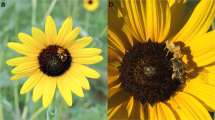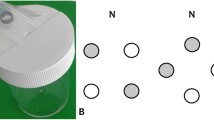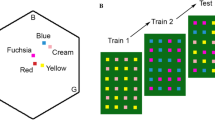Abstract
Predators hunting for cryptic prey use search images, but how do prey search for cryptic predators? We address this question using the interaction between bumblebees and the colour-changing crab spider Misumena vatia which can camouflage itself on some flowers. In laboratory experiments, we exposed bumblebees to an array of flowers concealing robotic predators (a trapping mechanism combined with a 3D life-sized model of a crab spider or a circle). Groups of bees were trained to avoid either cryptic yellow spiders or yellow circles (equal area to the spiders) or remained predator naive. The bees were then exposed to a new patch of white flowers containing some cryptic predators (either white spiders, white circles or a mixture of both). We monitored individual foraging choices and used a 3D video tracking system to quantify the bees’ flight behaviour. The bees trained to avoid cryptic spiders, chose 40% fewer spider-harbouring flowers than expected by chance, but were indifferent to cryptic circles. They also aborted a higher proportion of landings on flowers harbouring spiders, ultimately feeding from half as many ‘dangerous’ flowers as naive bees. Previous encounters with cryptic spiders also influenced the flight behaviour of bees in the new flower patch. Experienced bees spent more time inspecting the flowers they chose to reject (both with and without concealed spiders) and scanned from side to side more in front of the flowers to facilitate predator detection. We conclude that bees disentangle shape from colour cues and thus can form a generalised search image for spider shapes, independent of colour.






Similar content being viewed by others
References
Avarguès-Weber A, Deisig N, Giurfa M (2011) Visual cognition in social insects. Annu Rev Entomol 56:423–443
Berejikian BA, Tezak EP, LaRae AL (2003) Innate and enhanced predator recognition in hatchery-reared chinook salmon. Environ Biol Fishes 67:241–251
Boeddeker N, Hemmi JM (2010) Visual gaze control during peering flight manoeuvres in honeybees. Proc R Soc B 277:1209–1217.
Brown GE (2003) Learning about danger: chemical alarm cues and local risk assessment in prey fishes. Fish Fish 4:227–234
Chittka L, Niven J (2009) Are bigger brains better? Curr Biol 19:R995–R1008
Cooper WE (2009) Rapid covering by shadow as a cue to predation risk in three lizard species. Behaviour 146:1217–1234
Dixson DL, Munday PL, Jones GP (2010) Ocean acidification disrupts the innate ability of fish to detect predator olfactory cues. Ecol Lett 13:68–75
Dukas R (2001) Effects of perceived danger on flower choice by bees. Ecol Lett 4:327–333
Gonçalves-Souza T, Omena PM, Souza JC, Romero GQ (2008) Trait-mediated effects on flowers: artificial spiders deceive pollinators and decrease plant fitness. Ecology 89:2407–2413
Hempel de Ibarra N, Giurfa M (2003) Discrimination of closed coloured shapes requires only contrast to the long wavelength receptor. Anim Behav 66:903–910
Hershberger W (1970) Attached-shadow orientation perceived as depth by chickens reared in an environment illuminated from below. J Comp Physiol Psychol 73:407–411
Hunter LTB, Skinner JD (1998) Vigilance behaviour in African ungulates: the role of predation pressure. Behaviour 135:195–211
Ings TC, Chittka L (2008) Speed accuracy tradeoffs and false alarms in bee responses to cryptic predators. Curr Biol 18:1520–1524
Ings TC, Chittka L (2009) Predator crypsis enhances behaviourally-mediated indirect effects on plants by altering bumblebee foraging preferences. Proc R Soc B 276:2031–2036
Insausti TC, Casas J (2008) The functional morphology of color changing in a spider: development of ommochrome pigment granules. J Exp Biol 211:780–789
Kelley JL, Magurran AE (2003) Learned predator recognition and antipredator responses in fishes. Fish Fisheries 4:216–226
Lehrer M, Campan R (2004) Shape discrimination by wasps (Paravespula germanica) at the food source: generalization among various types of contrast. J Comp Physiol A-Neuroethol Sens Neural Behav Physiol 190:651–663
Lehrer M, Campan R (2005) Generalization of convex shapes by bees: what are shapes made of? J Exp Biol 208:3233–3247
Lendrem DW (1983) Predation risk and vigilance in the blue tit (Parus caeruleus). Behav Ecol Sociobiol 14:9–13
Lima SL (1985) Maximizing feeding efficiency and minimizing time exposed to predators: a trade-off in the black-capped chickadee. Oecologia 66:60–67
Lima SL, Bednekoff PA (1999) Temporal variation in danger drives antipredator behavior: the predation risk allocation hypothesis. Am Nat 153:649–659
Lima SL, Dill LM (1990) Behavioral decisions made under the risk of predation—a review and prospectus. Canadian J Zool-Revue Canadienne De Zoologie 68:619–640
Menzel R (1985) Learning in honey bees in an ecological and behavioral context. In: Hölldobler B, Lindauer M (eds) Experimental behavioral ecology, vol 31. Fischer, Stuttgart, pp 55–74
Morse DH (2007) Predator upon a flower: life history and fitness in a crab spider. Harvard University Press, Cambridge
Oliva D, Medan V, Tomsic D (2007) Escape behavior and neuronal responses to looming stimuli in the crab Chasmagnathus granulatus (Decapoda: Grapsidae). J Exp Biol 210:865–880
R Development Core Team (2004) R: a language and environment for statistical computing. In: R Foundation for Statistical Computing, Vienna
Ramachandran VS (1988) Perception of shape from shading. Nature 331:163–166
Reader T, Higginson AD, Barnard CJ, Gilbert FS (2006) The effects of predation risk from crab spiders on bee foraging behavior. Behav Ecol 17:933–939
Ruxton GD, Sherratt TN, Speed MP (2004) Avoiding attack. The evolutionary ecology of crypsis, warning signals and mimicry. Oxford University Press, Oxford
Skorupski P, Chittka L (2011) Is colour cognitive? Optic Laser Technol 43:251–260
Stach S, Benard J, Giurfa M (2004) Local-feature assembling in visual pattern recognition and generalization in honeybees. Nature 429:758–761
Tinbergen N (1960) The natural control of insects in pine woods: vol. I. Factors influencing the intensity of predation by songbirds. Archives Neelandaises de Zoologie 13:265–343
Troscianko T, Benton CP, Lovell PG, Tolhurst DJ, Pizlo Z (2009) Camouflage and visual perception. Phil Trans R Soc B 364:449–461
Turner AM, Turner SE, Lappi HM (2006) Learning, memory and predator avoidance by freshwater snails: effects of experience on predator recognition and defensive strategy. Anim Behav 72:1443–1450
Veen T, Richardson DS, Blaakmeer K, Komdeur J (2000) Experimental evidence for innate predator recognition in the Seychelles warbler. Proc R Soc B 267:2253–2258
Winnie J, Creel S (2007) Sex-specific behavioural responses of elk to spatial and temporal variation in the threat of wolf predation. Anim Behav 72:215–225
Wisenden BD (2000) Olfactory assessment of predation risk in the aquatic environment. Phil Trans R Soc B 355:1205–1208
Zhang SW, Srinivasan MV (1994) Prior experience enhances pattern discrimination in insect vision. Nature 368:330–332
Acknowledgements
We thank Oscar Ramos Rodríguez for technical support, Syngenta Bioline Bees for providing bumblebees and Dr. Peter Skorupski for commenting on an earlier version of this manuscript. TI and LC were supported by the Natural Environment Research Council (Grant NE/D012813/1) and MYW by the Overseas Research Students Awards Scheme and the Ministry of Education and National Science Council Taiwan Studying Abroad Scholarship. The experiments comply with the current laws of the country in which they were performed.
Author information
Authors and Affiliations
Corresponding author
Additional information
Communicated by J. Traniello
TC Ings and M-Y Wang authors contributed equally to this work.
Electronic supplementary material
Below is the link to the electronic supplementary material.
Suppl. 1
Experimental set up. Panel a shows a schematic of the flight arena housing the artificial meadow (dimensions are given in the text) and the axes used in the 3D flight path analyses (bold arrows). A close up of a ‘dangerous’ flower is given in panel b showing how the sponge coated pincers trap any bees which attempt to feed from the flower (PDF 756 kb)
Rights and permissions
About this article
Cite this article
Ings, T.C., Wang, MY. & Chittka, L. Colour-independent shape recognition of cryptic predators by bumblebees. Behav Ecol Sociobiol 66, 487–496 (2012). https://doi.org/10.1007/s00265-011-1295-y
Received:
Revised:
Accepted:
Published:
Issue Date:
DOI: https://doi.org/10.1007/s00265-011-1295-y




